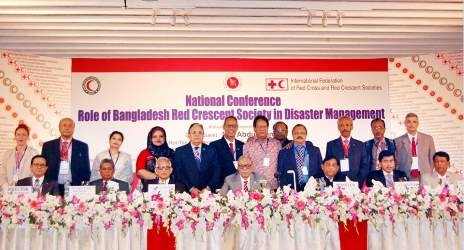
This combination means the impact of any disaster can be devastating and exceed people’s ability to cope. Many of the mega-trends that we were told to anticipate have already announced themselves in Bangladesh – such as migration, urbanisation and climate change. Every day an estimated 2,000 people arrive in the capital city, Dhaka, having left their villages looking for employment opportunities. Climate change is also now accelerating this race to the city.
The impact of climate change in Bangladesh makes for grim reading. Scientists predict that the glaciers in the Himalayas will melt faster, sending more floodwaters to batter the Bay of Bengal. Cyclones will wrack the coast more frequently, and with more intensity. Salty seawater will pollute drinking supplies. Fertile land will be destroyed.
However the people of Bangladesh are resilient and since the nation’s creation in 1971 they have had to constantly adapt to these new and emerging challenges. Over the past 45 years Bangladesh has made remarkable progress in its ability to both manage and reduce disaster risk and is a real success story on how sustained investment in holistic, comprehensive and local disaster risk management law, policy and actions really pays off. It is often cited as a global leader in disaster risk management.
Bangladesh Red Crescent Society (BDRCS), has played an integral role in these developments. Since its creation in 1973, BDRCS has continuously demonstrated its ability to adapt its approach to serve the people of Bangladesh. It has a huge number of trained young volunteers who play a vital role in any emergency, like the Rana Plaza building collapse and more recently in responding to Cyclone Mahasen. In fulfilling its auxiliary role in disaster management, BDRCS acts as an important conduit between authorities and communities.
Earlier this month the Government of the People’s Republic of Bangladesh, Bangladesh Red Crescent Society and IFRC came together to discuss collaborative approaches to disaster management in Bangladesh in a National Conference held in Dhaka. The conference was presided over by the Honourable President, Government of the People’s Republic of Bangladesh. The Ministers from the Ministry of Disaster Management and Relief and the Ministry of Law, Justice and Parliamentary Affairs, senior government officials and leadership from BDRCS as well as IFRC attended the event. Not only did the conference explore the role of Red Crescent in disaster management in Bangladesh, but also considered the legal and policy framework for managing and reducing disaster risk and also assessed how these frameworks can be strengthened to better protect some of the most vulnerable during disasters.
While there are many strengths in the Bangladesh model including a very comprehensive disaster management legal and policy framework, comprising the Disaster Management Act 2012, Standing Orders on Disasters ( SoD) and National Plan for Disaster Management and the Climate Change Strategy and Action Plan, conference participants identified some key areas that require further attention. These included domestic legal preparedness for international disaster assistance, better implementation of law and policy at the local level, a strengthened nexus between climate change adaptation and risk reduction initiatives as well as more focus on protection and inclusion issues during disasters, particularly for women, children and people with disabilities.
The Dhaka Declaration, the high level outcome document from the Conference, outlined ten key commitments for further collaborative approaches between BDRCS, IFRC and the government. These commitments will form the basis of the work plan for the coming years. The full text of the Declaration can be found here.
As a young nation, Bangladesh has a long history and depth of experience in dealing with number of disasters. As a country it has recognized lessons from the past and is showing global leadership to shift from reactive relief to proactive risk reduction, and this shift is encapsulated well in the domestic legal and policy frameworks. However with new and emerging challenges, there is continual need to learn and adapt. The collaborative approaches outlined in the Dhaka Declaration provide an exciting platform for future action between the Government of Bangladesh, BDRCS and IFRC, from parliamentary processes to the grassroots level, to ensure that communities in Bangladesh become even more resilient to the threats and challenges they face.